ISSN ONLINE(2319-8753)PRINT(2347-6710)
ISSN ONLINE(2319-8753)PRINT(2347-6710)
| Dr V. Lakshmana Rao Assistant Professor (c), Department of Meteorology & Oceanography, Andhra University, Visakhapatnam, India |
| Related article at Pubmed, Scholar Google |
Visit for more related articles at International Journal of Innovative Research in Science, Engineering and Technology
Air pollution in general occurs through both anthropogenic and natural sources but in the recent times, increasing population, growth of industries and rapid urbanization are more responsible for the increase in air pollution. The Air pollutants can also be broadly classified into two general groups.1) Primary Pollutants 2) Secondary pollutants. Primary pollutants are (a) fine particles less than 100 μrn (RSPM) (b) coarse particles >100 μm (TSPM), and (c) Sulfur and Nitrogen compounds, Secondary pollutants are formed by chemical and photochemical reactions of primary pollutants (acid rains). In the present study an attempt is made to see the implications of air pollution and its effects on the environment of an industrially developed coastal city. As a test case the data of the major primary pollutants like SO2, No2, TSPM (Total suspended particulate matter) and RSPM (Respirable Suspended Particulate Matter) for the years of 2001-2010 at various locations in Visakhapatnam are analyzed. The factors influencing the dispersion and dilution of air pollutants depends on mainly Meteorological and topographical factors. Here we discuss the seasonal rainfall distributions and local stability conditions how influence the dispersion and dilution of pollutants in annual time scales. Also an attempt is made on how these primary pollutants vary in a coastal developed city in the global warming era on seasonal and annual time scales.
Keywords |
| Rain fall, Coastal study, Global warming. |
INTRODUCTION |
| The Earth's atmosphere is a dynamic system that continuously absorbs of wide range of solids, liquids and gases from both natural and anthropogenic sources. These substances travel through air, disperse and react with one another and other substances both physically and chemically. Most of these eventually find their way into a depository such as ocean or to inceptor such as man, material, animal and vegetation. Some substances such as helium however escape from the biosphere. Various amounts of contaminants enter the atmosphere through both natural and anthropogenic that exists upon the earth. That portion of these substances which interacts the environment to cause toxicity disease, aesthetic distress, effects or environmental decay has been labeled by man as Pollutants. Mainly the actions of the people are the primary cause of pollution and as the pollution increases the attendant pollution problem also increase proportionately. Nature has considerable cleansing mechanism. The produced wastes are quickly transported by wind, diluted by turbulent diffusion and washed down by precipitation. |
Classifications of Air Pollutants |
| Air pollutants can also be broadly classified into two general groups. |
| a) Primary Pollutants |
| b) Secondary pollutants. |
| Primary pollutants are those emitted into the atmosphere directly, whereas the secondary pol lutants are formed by chemical and photo chemical reactions of primary pollutants |
(a) Primary Pollutant |
| A generalized list of primary pollutants was given by A.C. Stern (1976). They include (a) fine particles less than 100 urn in diameters, (b) coarse particles (>100 um in diameter), (c) sulfur compounds, (d) organic compounds (e)Halogen compounds and (f) radio active compounds. The final aerosols include particles of metal, carbon, tan, resin, pollen, fungi, bacteria oxides of nitrates, sulfates, chlorides, fluorides, silicates etc. coarse particles include the same with their diameter exceeding 100μm. The sulfur compounds include sulfur dioxide (SO2), sulfur trioxide (SO3) Hydrogen sulfide (H2S). Organic compounds include a number of aliphatic and aromatic hydrocarbons. The Nitric compound includes nitric nitrogen dioxide and Ammonia certain other metallic pollutants do present in the atmosphere such as lead, mercury etc. |
(b) Secondary Pollutants |
| These are formed by chemical and photochemical reactions of primary pollutants. The total polluted a i r mass over a populated area is chemically and physically unstable. The whole system tends to approach a state of minimal free energy. The steps involved in such a process are influenced by many factors such as relative concentrations of reactions, degree of photo activation, variable meteorological dispersive forces, and influence of local features like topography, lakes and water vapor. Acid mist when combined with metallic oxides give rise to halide salts from which subsequently acid mist is formed by further chemical reactions. For example dissolved oxygen with sulfur oxides form sulfuric acid mist. The process accelerates in the presence of certain metallic oxides. The photochemical event is the dissociation of nitrogen dioxide giving rise to nitric oxide and oxygen radicals. The various secondary pollutants that can be identified d u e t o this process are ozone, formaldehyde, Peroxyacetylnitrate (PAN). These are some of the secondary pollutants that are produced from the Primary pollutants either undergoing chemical reactions or photochemical reactions. |
ACID RAIN FORMATION AND DECOMPOSITION: |
| When sulfur dioxide and nitrogen dioxide are released, they mix with oxygen and water in the air to form acid rain. These chemicals can travel long distance in the wind before being deposited. When power stations burn coal, they release sulfur dioxide (SO2) and nitrogen oxide (“NOx” gases like NO2) into the atmosphere. These chemicals sometimes fall back to the ground (dry deposition). On other occasions they combine with water vapor in the air and form dilute acids in the rainwater. |
FACTORS INFLUENCING AIR POLLUTION: |
Meteorological Aspects: |
| In recent years people have been made aware of the environmental s problems caused by the high technology, to achieve the material comforts they demand. Among these problems, Air Pollution is the fir st and the foremost. It was already pointed out that the pollutants cannot affect unless they are in sufficient concentrations. The concentration of pollutants that are thrown in to the atmosphere depends upon the source strength, prevailing meteorological conditions and the topography. Rapid dispersal leads to lower concentrations whereas stagnation conditions result in high concentrations, which can create adverse effects on human health. If the stagnations continues for longer periods, the concentrations and effects also increase proportionately, which is known as 'episode1. So to know such conditions, the forecast of concentrations is essential which needs the knowledge of air pollution cl imatology / meteorology of that par ticular legality. This can be effectively used while planning major industries or urban centers with ecological impact, so that the air pollution concentration can be minimized. The important meteorological parameters like wind vector, turbulent diffusion, Atmospheric stability, relative humidity, precipitation, mixing heights and ventilation coefficients, transport Wind speed. |
AIR POLLUTION SCENARIO IN VISAKHAPATNAM: |
| Unpleasant fumes and odors, reduced visibility, injury to human health, crops and forms of vegetation by noxious pollutants and damage to property by dust particles and corrosive gases rank among the major environmental problems of urban and industrialized areas and their surroundings. The fact was true with Visakhapatnam (17°42'N; 82°18'E) a The physiographic of Visakhapatnam exhibits distinctly three broad relief features |
| I) The two hill ranges forming northern (Kailasa range) and Southern (Yarada range) borders |
| II) The waltair highlands extending along the shore |
| III) Extensive tidal swamp on the west and |
| IV) Bay of Bengal on the eastern side. |
| The Kailas range (Northern hill range) is about 16km long rises abruptly from the seashore and gradually extends west wards culminating in its central highest part at Thomas Folly (506m). Thereafter, it gradually decreases west ward. The head land, projecting to the East in to the Sea (Rushikonda) has been separated from the range by a gap through which flows a stream known as Hanumanthavaka Gedda. Thus, except at this gap, the hill range forms an inaccessible natural boundary. The Southern hill range known as Yarada also forms an inaccessible boundary running for about 8km., from the shoreline in the East-West direction. The head land projects boldly into the sea and forms a cliff. After the shape of its projection it is known as Dolphins nose. The height of the range gradually increases eastward attaining its maximum at Yarada Konda (358m). Its height decreases westward and ends abruptly. Here in this study we taken major air pollutants are TSPM(Total suspended particulate matter), RSPM(Respirable suspended particulate matter),So2and No2 in different regions in the Visakhapatnam urban region those are Mindi(BHPV),IEMarripalem(Industrial Area),Police Barracks(Transportation),Gnanapuram(Industrial Port area), Veerabahu (INS Kalinga) Seetammadhara(Domestic area) in the years 2007-2010 Because Visakhapatnam is a Different topography and Coastal Region the sea and Land Breezes also effects ejecting the pollutants and also in this recent year’s growth of the industrial and Domestic Transportation also will increases. |
III. RESULTS AND DISCUSSION |
| Results from the observations indicate that the total TSPM(Total suspended Particulate matter) has shown an increasing trend reaching a maximum of 239μg/m3 in the year 2009.In the last year that is 2010 the value recorded was 162 μg/m3 of TSPM. These see saw variations the recent years may be attributed to the variability in the rainfall over Visakhapatnam. In the year 2009 Visakhapatnam received less rainfall 734.3mm (around 27% deficient) compared to average rainfall 944mm as compared to 1702.5mm in the year 2010. The result being due to the wash out factor is more in the year 2010.similarly figure 2 , which shows the year wise RSPM(Respirable suspended particulate Matter) shows a similar trend, showing a maximum of 97 μg/m3 of RSPM in the year 2009. This coincides with the high incidence of respiratory diseases recorded in Visakhapatnam. Observations of oxides of Sulfur and Nitrides are presented in the figures 3 & 4 respectively. Observations indicate that the values of oxides of Sulfur always coincided with surplus rainfall years. It is clearly seen that in 2009 the values are recorded reached a maximum value of 18 μg/m3 of SOx. This yielded deficient rainfall 734.3mm. Similarly the observed values of NOx are presented in figure 4. In all the years the contents of NOx is observed. The values recorded 18 μg/m3 and 7.35 μg/m3 respectively bad and good monsoon years 2009&2010.the minimum value of 6.2 μg/m3 was recorded in 2003 which is a good rainfall year for Visakhapatnam and the value 7.32 μg/m3 in the year 2010 can be attributed excess rainfall of 1702.5mm over Visakhapatnam. |
IV. SUMMARY AND CONCLUSIONS |
| The present paper deals with the observations of primary air pollutants over highly industrialized coastal city of Visakhapatnam situated in the East coast of India. The meteorological factors responsible for the high incidence of these pollutants are discussed. Results indicate that there is a clear indication of the role of atmospheric variables on the values of air pollutants. The future scope of this work is to increase the network of observational platforms and to see the impact of these pollutants population Visakhapatnam in terms of intra annual and intra seasonal variability. |
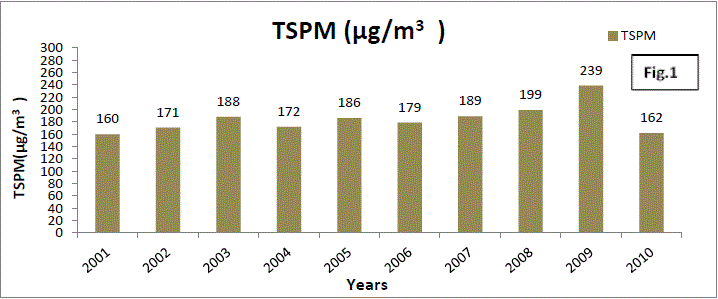 |
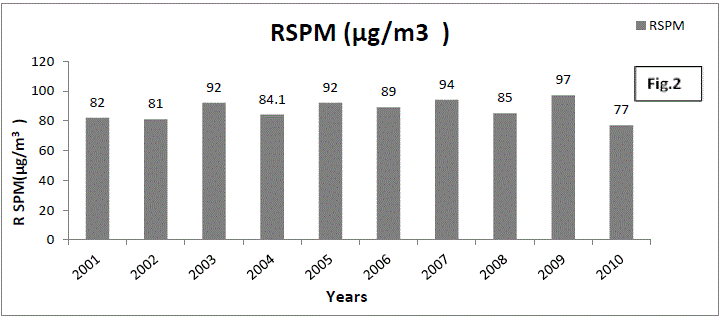 |
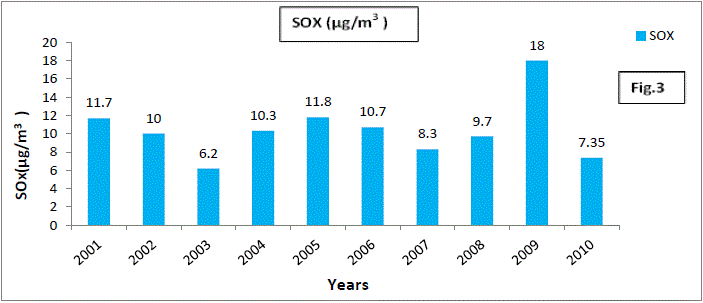 |
| Annual variations of SOx, NOx and rainfall are shown in figures 3,4&5. |
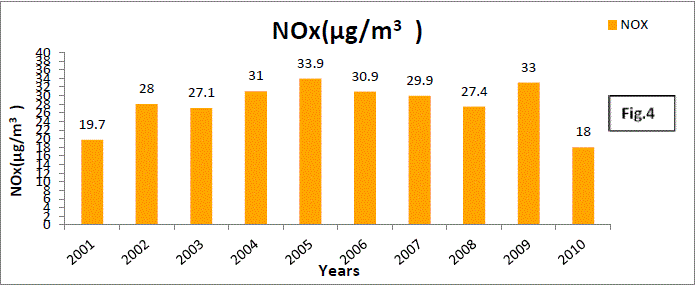 |
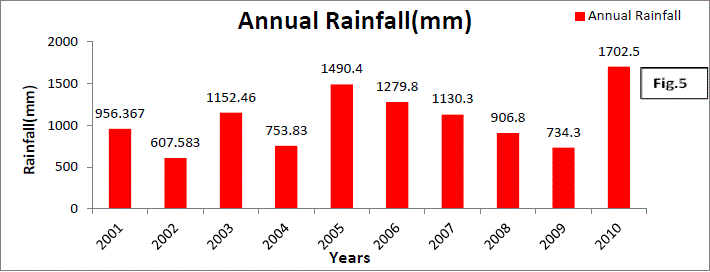 |
References |
|